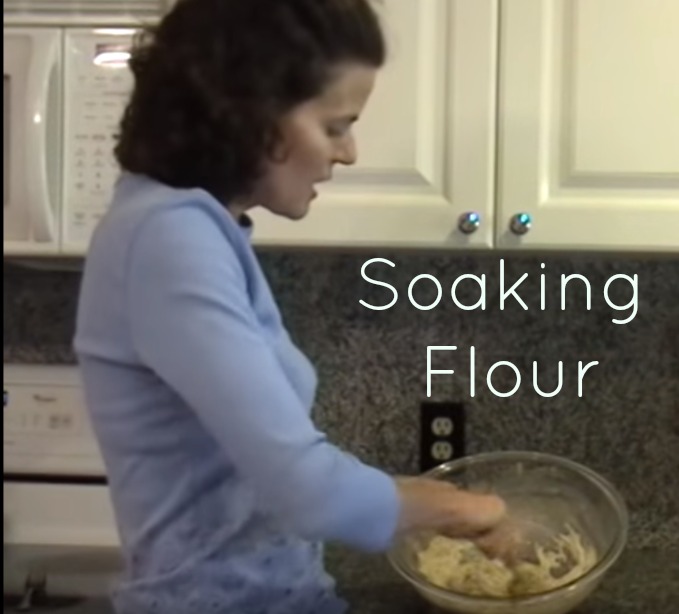Table of Contents[Hide][Show]
Soaking flour for maximum digestibility is one of the three traditional methods of grain preparation for healthy, nutritious bread as practiced by Ancestral cultures.
One of the most important baking techniques to learn when implementing a traditional diet is soaked flour. This ancestral method of grain preparation enhances digestibility and improves the metabolism of nutrients.
This technique also reduces anti-nutrients such as phytic acid in the grain flour. These substances block mineral absorption and can aggravate inflammation of the intestinal tract. Gluten-free grains also contain these anti-nutrients.
Other methods for reducing anti-nutrients in grains and improving metabolism include sour leavening (sourdough) and sprouting.
How to Soak Flour
Soaking flour is simple. Simply mix grain flour with yogurt, kefir, or clabbered milk, cover with a dishtowel, and let sit on the counter overnight. Freshly ground flour produces the best results. After the allotted soaking time, blend in the remaining ingredients and bake or cook as usual.
Non-grain based flours such as cassava and coconut flour do not need soaking. Others such as almond flour and chickpea flour are best soaked before grinding rather than after.
Dairy-Free
For those with milk allergies, substitute 1 cup of filtered water per cup of flour plus 2 TBL of lemon juice or apple cider vinegar and soak as usual for at least 8 hours or overnight.
For those with more extreme wheat sensitivities, the soaking time can be increased up to 24 hours to further breakdown gluten and other anti-nutrients.
Soaking any longer than 24 hours risks the development of mold.
Soaking Flour Technique Applies to All Grains
The principle of soaking can be applied to whole grains as well, such as your morning oatmeal. It was common to soak oats overnight before cooking back before WWII. This step was apparently even suggested on the Quaker oatmeal box!
It seems with the modern preference for speed in food preparation, this essential step has been lost. Hardly anyone under the age of 80 even remembers it anymore.
Try soaking your oatmeal the night before and see how much more filling it is after you cook and eat it the next morning.
Instead of being hungry again at 10 am, you will likely be full right through until lunch! To soak oatmeal, use 1 cup of warm filtered water per cup of oats plus 2 TBL whey, yogurt, kefir, or buttermilk. Stir together in the pot you will cook them in, cover with the lid, and leave overnight.
Cook, as usual, the next morning.
Bread Recipes Using Soaked Flour
Try this soaked bread recipe with your soaked flour. You can also try making a soaked loaf in a bread machine.
The video in the recipe tutorial below demonstrates visually the simple process of soaking flour. Try it with your next flour-based recipe!

How to Soak Flour
How to soak flour of all kinds before making the batter to improve digestibility and nutritional benefits of bread and other baked goods.
Ingredients
- 2 cups flour preferably freshly ground and organic
- 2 cups whole milk yogurt
Instructions
-
Mix flour and yogurt in a large bowl.
-
Cover with a clean dishcloth and secure with a large rubber band.
-
Leave on the counter overnight or for 8 hours.
-
Uncover, mix in remaining ingredients for whatever recipe you wish to make and bake as usual.
Recipe Video
Recipe Notes
Clabbered milk or plain kefir may be substituted for yogurt.
If there is a dairy allergy, 2 cups of water plus 2 Tbl lemon juice may be substituted. This reduces the calories to 910 for one batch.








Hi, How is this technique different from sprouting the grains first, dehydrating them and then preparing the flour? Do the anti-nutrients get further deactivated/removed by the procedure i mentioned or is the technique you suggested equally good for removing the anti-nutrients?
Here is an article that explores sprouting vs soaking in depth. https://www.thehealthyhomeeconomist.com/sprouting-vs-soaking-fermentation/
Hi Sara,
In order to break down more of the grains lectin proteins and antinutrients what would be the maximum safe time that I can soak grains or flours on my countertop? The longer you soak, the more that the antinutrients and the lectin proteins get broken down, right? Do I need to change out the water if I can soak longer than 24 hours? And when soaking grains, do I strain off the fermented liquid then and rinse grains before cooking? Thanks for educating us all. Very thankful. I have two boys with autoimmune disease, so am doing everything I can to improve there gut health, so that they may one day be off of there immune suppressant drugs. Carmy
You really aren’t going to achieve better results going longer …you will just risk the flour going moldy or getting too dry. Follow the recipe above for best results.
Can one soak Einkorn flour this way, too?
Yes you can 🙂
Can you soak overnight in the fridge? Does it have to be at room temperature?
Thank you,
Anna
The flour needs to soak at room temperature.
I am trying to convert a muffin recipe that calls for 2 1/2 cups whole wheat flour, 1/2 cup buttermilk, and 1/2 cup melted butter. These would be combined to form the soaked batter. After I had combined these ingredients the batter turned out to be closer to a dough, moistened and somewhat crumbly–not very wet at all. How wet should soaked flour be to be effective? Maybe not all recipes can be converted? I’ll be finishing my muffins tomorrow so I’ll see what happens.
thank you! If I understand, I can soak wheat flour ( preferably whole grain) in either yoghurt or milk to “deactivate” (so to speak) my gluten sensitivity or allergy. I have been reading “nourishing Traditions” and am also going to try making a sourdough starter.
Hi Sarah I watched your video soaking flour, very helpful thank you, the reason I am also interested in the soaking method is I’m interested in the eat right for your blood type, and as I’m B+ wheat is not allowed, and I think that’s because of the gluten and lectins, so I’m hoping the soaking will help make the flour more digestible Thanks
Do you still add the remaining milk or water since it is already moist? How about for breads? What would I need to do to make bread this way? Thank you so much for sharing your knowledge.
I would recommend the cookbook Nourishing Traditions that has bread and other recipes for baked goods specifically designed for soaked flour.
Hello Sarah, I buy a stone ground ready to mix four which also contains dried cane juice, baking powder, baking soda and sea salt. I really like it to make muffins that I can have in the morning but I was wondering if I could soak this mixture over night? My main concern is the cane juice. I do not want bacteria to grow.
Thanks
This mixture is not appropriate for soaking. It must be flour only, ideally freshly ground.
This procedure doesn’t make any sense at all from a health and nutritional standpoint, anti-nutrients are still there in the batter. You soak overnight to DISCARD the “bad stuff” in the morning. Rinse and repeat whereas necessary.
“Important caveat: Lectins are resistant to DRY HEAT such as what would occur in baking. Thus, cooking with legume flours for breads and similar foods is neither traditional nor prudent if the legumes aren’t soaked or sprouted first.”
https://www.thehealthyhomeeconomist.com/lectins/
The remnants of the anti-nutrients are there, but they have been deactivated. They are no longer a problem so no need to rinse, discard or do anything else.